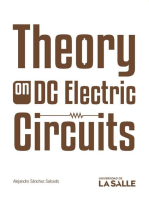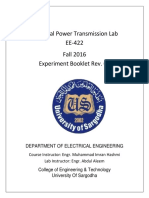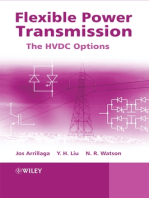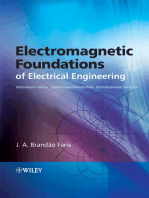2.1 Protection Development Branch: Industrial Training Report
Uploaded by
Isuru Pasan Dasanayake2.1 Protection Development Branch: Industrial Training Report
Uploaded by
Isuru Pasan DasanayakeChapter 2 CEB Industrial Training Report
2.1 Protection Development Branch
2.1.1 Introduction
According to the schedule which was given by the Training Centre of Ceylon Electricity Board I
was appointed to the Protection Development Branch at Dematagoda for one week. This branch
stands for develop and monitor the protection system of the transmission network of CEB. This
branch is controlled by the Chief Engineer Mr.N.S.Wettasinghe and several Electrical Engineers
work under him. In the first day at the Protection Development Branch I gained a basic
knowledge about protection methods of transmission lines.
2.1.2 Transmission Line Protection Methods
Differential Protection
In this method fault is identified by comparing the current entering and leaving a protected
section. By comparing the magnitude and phase of the currents at the two ends, it is possible
to determine whether the fault is internal or external.
Over Current protection
Fault current varies with position of the fault. Variation is due to the impedance of the plant
between the source and the fault. Appropriate time intervals are given for each relay.
Operation of the relay is hence independent of the fault current. Relay nearest to the fault will
operate and trip the breaker.
Tripping Time
Figure 2.1 TRIP TIME CHARACTERISTIC Fault
Current
Department of Electrical Engineering Page 7
University of Moratuwa
Chapter 2 CEB Industrial Training Report
Distance Protection
Distance of a transmission line is fixed and determined at the time commissioning. It remains
constant under all system conditions. Hence measurement of distance of a transmission line
is a good concept. If the distance measured is less than the “known”, that indicates a faulty
condition. If it is more than the “known” it indicates a healthy condition. In this method an
impedance relay is set to operate when the impedance measured is less than the preset value.
Earth Fault Protection
Earth fault conditions are always associated with residual currents. Hence by detecting
residual currents earth fault can be detected. Earth fault currents can be of low magnitudes
and over current relays may not detect those. Therefore sensitive earth fault relays are used if
very low earth fault currents are to be detected.
2.1.3 Biyagama Receiving Station
When I was at the Protection Development Branch I got the chance to visit Biyagama Receiving
Station with an Electrical Engineer. At there I observed transmission line protection relay
installation which was being done by SIEMENS Company’s technical officers. As well as I was
able to observe and study the components and the switching network of the switchyard of the
Sub station. The single line diagram of the Biyagama Switching Station is provided in the Annex
A6,2,1,3.
2.1.4 Protection Monitoring System
This system has been implemented as a communication system which does network the
substations using fiber optic cables. All the Engineering PCs of all the connected substations can
be remotely accessed from master computer at the Protection Development Branch by using this
system. I was also able to observe how to access and control transmission line and relay data
using the master computer. A figure of the existing Protection Monitoring System is provided in
the Annex A7,2,1,4.
Department of Electrical Engineering Page 8
University of Moratuwa
Chapter 2 CEB Industrial Training Report
2.2 Asset Management Hydro Electrical
2.2.1 Introduction
Asset Management branch of CEB is situated in Kandy and it stands to handle and monitor the
protection of the generators of all CEB owned hydro power stations in Sri Lanka. Most of the
repairs and tests of protection equipments of the generators and relays are done in this branch.
This branch is supervised by a Deputy General Manager and I trained under the Chief Engineer
Mr. Tennakoon for one week.
2.2.2 Calibrating a Power and Energy Meter
When I was at the Asset Management Branch I was able to involve calibrating a YOKOGAWA
power and energy meter that had to be fixed to the control unit of the Inginiyagala power station.
Calibration was done by injecting current of 1A to the energy meter by using OMICRON testing
device. The results we obtained are as follows.
VT Ratio = 60:1 , CT Ratio = 80:1
Input Voltage Phase Angle Meter Reading Theoretical Value
63.5 V 0º 0.91 MW 0.9144 MW
63.5 V 20 º 0.86 MW 0.8592 MW
63.5 V -100 º -0.16 MW -0.1588 MW
63.5 V -20 º -0.32 MVAr -0.3127 MVAr
63.5 V -50 º 0.58 MW 0.5878 MW
Table 2.1 RESULTS OF THE CALIBRATION
2.2.3 Training Experiences
When I was at the Asset Management Branch I studied some operation and maintenance manuals
and project reports of Kotmale and Victoria projects. And also I involved in a testing which was
being done of a field failure relay which had been removed from New Laxapana power station.
The relay was tested for the correct functioning. In the final day of that branch I was able to
observe a testing of a VIBROSYSTM Air gap sensor which is used to measure the air gap length
of generators. The unit was tested to check whether it is working properly and found out that
there was a fault in the unit.
Department of Electrical Engineering Page 9
University of Moratuwa
Chapter 2 CEB Industrial Training Report
2.3 Sapugaskanda Grid Substation
2.3.1 Introduction
According to my schedule I was appointed to the Transmission Operation and Maintenance
Branch at Dematagoda in my third week of training. Chief Engineer of that branch assigns me to
train at Sapugaskanda Grid Substation for one week. Sapugaskanda grid substation is situated
near Kiribathgoda and it is supervised by an Electrical Superintendent. Four 132kV transmission
lines come to the substation from Biyagama and Kelanitissa while eleven feeders go out. This
substation consists of four 132kV/33kV power transformers and a Gas Insulated Switching (GIS)
system. Although it has 4 transformers 3 of them had been burnt and the total load was delivered
through one transformer which was running under full load when I arrived there. And there was
a newly installed transformer which had to be commissioned.
2.3.2 Commissioning of newly installed power transformer
Features of the newly installed transformer
Type: DT 4W 35800/132
Rated frequency: 50Hz
Type of cooling: ONAN/ONAF
Rated power: 23,000/31,500kVA
Rated current: 100,6/137,8 A
Symmetrical short circuit current: 1.33kA
Connection symbol: YNd1
Max ambient temperature: 40oC
Temperature rise of top oil/winding: 50/55oC
Impedance voltage at 75oC (%)
@ 145,200V – 11.06
@ 132,000V – 10.35
@ 112,200V – 9.53
At 31,500kVA duration maximum: 2s
When I reached the substation the final oil filling process under vacuum of the transformer was
being performed. In the following days several tests of commissioning the transformer were
carried out. And I was also able to involve and observe Insulation resistance test, Polarity test
Department of Electrical Engineering Page 10
University of Moratuwa
Chapter 2 CEB Industrial Training Report
(Vector group), Ratio test, Short circuit test and Thermometer test which were done for the new
transformer.
Obtained results of the Ratio test
Tap Primary(V) Secondary(V) Name Measured
RY YB BR ry yb br plate ratio
No.
1 393 394 393 89 89.3 89 4.4 4.41
2 393 394 393 89 89 89 4.35 4.42
3 394 395 393 90 90 90 4.3 4.38
19 393 393 393 111 111 3.5 3.5 3.54
20 393 393 392 112 112 3.45 3.45 3.51
21 392 393 392 114 114 3.4 3.4 3.44
Table 2.2 RESULTS OF THE RATIO TEST
Obtained results of the Insulation Resistant test
HV to (LV + Ground) – 5kV
Polarization Index = MΩ (10 min)
Time (Min) Resistance(GΩ)
1 10.2 MΩ (1 min)
3 16.9 = 22.7 = 2.23
5 18.8
10 22.7 10.2
LV to (HV + Ground) – 5kV Polarization Index = MΩ (10 min)
Time (Min) Resistance(GΩ)
1 10.7 MΩ (1 min)
3 17.4 = 27.2 = 2.54
5 21.1
10 27.2 21.1
The polarization index should be greater than 2 of a transformer which has a good insulation
level.
2.3.3 Training Experiences
At there I was able to observe the way of measuring the breakdown voltage of transformer oil.
Also I observed a test which was done to measure the moisture level of the transformer oil and
found the result as 11 PPM. In addition to that I obtained a fair knowledge about the 33kV GIS
system.
Department of Electrical Engineering Page 11
University of Moratuwa
Chapter 2 CEB Industrial Training Report
2.4 Generation Planning Branch
2.4.1 Introduction
Generation Planning Branch of CEB is situated in the CEB Head office building. This branch is
supervised by a DGM and I trained under the Electrical Engineer Mr.Anuradha for one week.
The major task done by this branch is planning the future electricity generation system of the
country in order to meet the future electricity demand. When planning this system primarily the
capability of the existing generating system is assessed. Then analyze whether it can meet the
energy demand in future. If the existing system fails to do that a candidate system should be
prepared to satisfy the demand. Details and costs of candidate thermal and hydro plants which
are to be considered for system addition are obtained from various pre-feasibility and feasibility
studies commissioned by the CEB in the recent past. Every year this branch publishes a Long
Term Generation Expansion Plan (LTGEP) for 10 years and I was able to study the LTGEP
2009-2022 plan when I was there.
2.4.2 National Demand Forecast
To plan the future generation system a forecast of the future electricity demand is strongly
required. Therefore every year a report for 20 years which contains the predictions of the future
energy demand in the country is also published by this branch and it is called as the National
Demand Forecast. This forecast is done by analyzing the past data such as GDP, past electricity
demand, total energy losses and etc. And I was able to study the National Demand Forecast
(2008-2028) when I was there.
2.4.3 WASP Simulation Software
After preparing the demand forecast, generation plan is prepared using the simulation software
WASP (Wlen Automatic System Planning Package). The key inputs for the software are study
period, demand and load duration data, plant data, committed development plan, emission factor
for each plant, reserve margin, spinning requirement in the system, development cost,
construction period, economic parameters and etc. When I was at this branch I experienced how
to implement a Generation Expansion Plan using this software and I studied the output report
given by the software as well.
Department of Electrical Engineering Page 12
University of Moratuwa
Chapter 2 CEB Industrial Training Report
2.5 Transmission Planning Branch
2.5.1 Introduction
Transmission Planning Branch of CEB is situated in the CEB Head office building. This branch
is supervised by a DGM and I trained under the Electrical Engineer Mr.Priyadarshana for one
week. The major task done by this branch is designing of grid substation and transmission lines
according to the upcoming generation plans. Every year this branch publishes a Long Term
Transmission Development Plan for a time period of 8 years. This plan is prepared by analyzing
the Long Term Generation Expansion Plan, National Demand Forecast and Regional medium
voltage distribution plan. Preparing tender documents and shifting of transmission lines when
required are also functions of this branch. A schematic representation of the transmission process
is provided in the Annex A8,2,5,1.
2.5.2 Training Experiences
When I was at the Transmission Planning Branch I was able to study the Long Term
Transmission Development Plan (2008-2016) and I obtained a fair knowledge about the
procedure of preparing a Transmission Development Plan. And also I learn the way of preparing
a Grid wise Demand Forecast. As well as I was able to obtain a fair knowledge about the
Moragolla hydro project which is currently in its feasibility study stage. At there I experienced
how to implement a Transmission Development Plan using the simulation software “PSSE”
(Power System Simulation for Engineering). In addition to that I met an Electrical Engineer from
New Zealand who had come to the Transmission Planning Branch to monitor an existing project
and he gave me a presentation about the SWER (Single Wire Earth Return) technology which is
used to distribute electricity in rural areas in countries like Australia and New Zealand.
Department of Electrical Engineering Page 13
University of Moratuwa
Chapter 2 CEB Industrial Training Report
2.6 Sapugaskanda Diesel Power Station
2.6.1 Introduction
Sapugaskanda Deisel Power Station is supervised by its Chief Engineer and I trained under him
for one week.First stage of the Sapugaskanda Diesel Power Station was implemented in 1984
with four 20MW diesel generators. First expansion of the plant has been commissioned in 1998
with another four 10MW diesel generators. In the second expansion of the Sapugaskanda Diesel
Power Station four additional 10-MW diesel generator sets were installed, and commissioned in
1999 increasing the installed capacity from 120 MW to 160 MW. When I was there I was able to
obtain a fair knowledge about the process of generating power in the power plant.
2.6.2 Generation Process
In this power plant the generated are operated using diesel engines. Therefore Fuel is the major
material which needs more to do the operations in the power station. There is a fuel supply line
to the power station from the Ceylon Petroleum Cooperation. Heavy fuel is pumped through that
line and there are 4 storage tanks inside the plant premises to store the heavy fuel. And there are
also 2 storage tanks to store diesel. Although it is called as a diesel power station heavy fuel is
used to operate the engines. But diesel is used as the fuel at the starting of the engines. After
running sometime from the starting fuel type is converted to the heavy fuel. Heavy fuel is not
directly supplied to the engines due to its high viscosity. Therefore there are two fuel treatment
houses in the power station to treat the heavy fuel and 3 storage tanks to store the treated heavy
fuel. Before the fuel is sent to the treatment plants there are sludge separator units to separate the
sludge from the heavy fuel. Lube oil is supplied to the generators through separate lines.
Engines are cooled using the water and there is water storage tank which has volume of 3000 m³
to store the cooling water. Engine cooling procedure is done in a closed cycle. The water that
comes out of the engines after absorbing the heat is sent to a cooling tower and sent back again
to circulate inside the engines. As well as there is a separate radiator bank to cool the water that
comes out from the engines in the Station B. The Process Flow Diagram of the power station is
provided in the Annex A9,2,6,2.
When I was there I was able to observe and study the above whole process. As well as I was able
to study the switch yard of the power station and learn about the duty which is done by the
control rooms.
Department of Electrical Engineering Page 14
University of Moratuwa
Chapter 2 CEB Industrial Training Report
2.7 Kotmale Hydro Power Station
2.7.1 Introduction
Kotmale Power Station is Supervised by its Chief Engineer and I trained under 4 Electrical
Engineers for one week. The Kotmale project was one of the first projects taken up under the
development of Mahaweli Complex. The Kotmale project was started with the construction of an
87 m high Rockfill dam across the Kotmale Oya. The water stored in the reservoir is conveyed
through an underground tunnel system to an underground power station situated in the belly of
the Atabage Mountains at about 7.2 km away from the dam for generation of electric power.
After power generation, this water is discharged through the outfall into the mahaweli ganga at
the Atabaghe Oya confluence.
Kotmale Power Station was commissioned in 1986 with three 67MW generators and still it
contributes about 445 GWh of power to the national grid annually. The underground power
station the power station consists of 3 vertical francis turbines which have the ratings of 67MW
at 201.5m head and at the speed of 375 rpm. Unlike the other power plants the power house,
administration office and the control room of Kotmale Power Station are located in 3 places far
apart from each other. Power house which contains turbines and generators are located
underground and there is a separate tunnel to enter that. The Administration building is situated
near that tunnel entrance while the Control room and the switch yard is situated top of the
Atabage Mountain.
2.7.2 Training Experiences
When I was there I was able to study the control room of the power station and observe how to
start a machine and connect to the system being in the control room. As well as I studied the
switch yard, single phase power transformers and auxiliary transformers and obtained a fair
knowledge about the switching network. And also I got the opportunity to go the underground
power house and observe some steps of an annual maintenance of a generator which was being
performed. At there I got the chance to enter in to the penstock and walk trough the spiral casing
of a turbine while inside of that was being cleaned. And also I observed the downstream surge
chamber. During that week I got the chance to involve in a first aid training program which was
held for the workers of the power station.
Department of Electrical Engineering Page 15
University of Moratuwa
Chapter 2 CEB Industrial Training Report
2.8 System Control Centre
2.8.1 Introduction
System Control Centre of CEB is situated in Dematagoda and it is supervised by a DGM. During
the one week period at there I trained under the Chief Engineer of that branch. Main task done by
this division is balancing the power generation and demand in the country to maintaining a high
quality power supply. It is done by controlling the output of all the generators in power plants by
communicating with the power plants. System Control Centre maintains a direct connection with
all the major electrical power generating stations via power line carrier system.
2.8.2 Duties and Functions
System Control Centre decides which power generators should run at a particular time of the
day. The decisions are made by the System Control Engineer by analyzing the load curve which
is updated every time using SCADA system. When the demand increases above the supply
system frequency tends to drop down. But it is the responsibility of the systems control branch to
control the system frequency within standard limits between 49.5Hz – 50.5Hz. Since the total
demand varies every time system frequency controlling normally handed over to one hydro
power station. But this plant can control the system frequency up to some extend only according
to the total demand. When controlling the hydro power plants’ output, water management
directives also should be considered since the irrigation system is not only used by the power
plants and water levels of the reservoirs also should be considered. In addition to that this branch
prepares a Monthly Rolling Planned Outage Report including all the generators’ planned
outages. This report is very helpful in planning daily generation procedures. The Monthly
Rolling Planned Outage Report for the month of May in 2010 is provided in the Annex
A10,2,8,2.
As well as this branch is responsible for the coordination and operation of the 220kV and 132kV
transmission network. The operation of the transmission system is planned by the System
Control Branch when an interruption is required in transmission lines.
Department of Electrical Engineering Page 16
University of Moratuwa
Chapter 2 CEB Industrial Training Report
2.8.3 Policy on Power System Operation in CEB
System Operation Priority Water Usage priority
Safety of persons Water service and drainage
Protection of equipment Environment
Availability of Supply Irrigation
Quality of supply Power
Economics of system operation
System Voltage
As Normal Under emergency
220 kV ( ± 5% ) 220 kV ( + 5% or – 10% )
132 kV ( ± 10% ) 132 kV ( ± 10% )
33 kV ( ± 2% )
System Frequency
The statutory frequency limit is 50 Hz ±1%.
Spinning Reserve
Spinning Reserve Margin to be not less than 5% of gross generation.
Maximum Generator Unit
The maximum load of any generation unit shall be less than 20% of gross generation.
2.8.4 Training Experiences
When I was there I learned how to balance the supply and the demand by dispatching the power
generation. And I analyzed every time the load curve, the system voltage and the power
generation data which were being updated by SCADA system. As well as I studied the water
management directives which had been assigned for the week I was there and learned the
importance of that. Also I experienced how to take most suitable and economical decision when
deloading the thermal power generation. In addition to that I was able to learn how to plan
transmission line interruptions by analyzing the Load Flows using “Power World Simulator”
software.
Department of Electrical Engineering Page 17
University of Moratuwa
You might also like
- Practical Guides to Testing and Commissioning of Mechanical, Electrical and Plumbing (Mep) InstallationsFrom EverandPractical Guides to Testing and Commissioning of Mechanical, Electrical and Plumbing (Mep) Installations4/5 (4)
- Trilogy of Wireless Power: Basic principles, WPT Systems and ApplicationsFrom EverandTrilogy of Wireless Power: Basic principles, WPT Systems and ApplicationsNo ratings yet
- What Are The Advantages and Disadvantages of Radial and Ring Distribution? Radial Distribution System100% (1)What Are The Advantages and Disadvantages of Radial and Ring Distribution? Radial Distribution System5 pages
- Tamil Nadu Electricity Board: Manual On Pre-Commissioning & Periodical Testing OF Electrical Installation100% (3)Tamil Nadu Electricity Board: Manual On Pre-Commissioning & Periodical Testing OF Electrical Installation266 pages
- A Vocationa Training Projec Report ON: EHT DN. C.S.P.T.C. (Bhilai-3)No ratings yetA Vocationa Training Projec Report ON: EHT DN. C.S.P.T.C. (Bhilai-3)18 pages
- Rise Krishna Sai Polytechnic: Department of Electrical & Electronic EngineeringNo ratings yetRise Krishna Sai Polytechnic: Department of Electrical & Electronic Engineering44 pages
- The Fundamentals of Protection Relay Co-Ordination and Timecurrent Grading PrinciplesNo ratings yetThe Fundamentals of Protection Relay Co-Ordination and Timecurrent Grading Principles9 pages
- Laboratory Manual Power Systems Laboratory (R18A0287) Iv B.Tech I - Sem (Eee)No ratings yetLaboratory Manual Power Systems Laboratory (R18A0287) Iv B.Tech I - Sem (Eee)54 pages
- Department of Electrical Engineering: Project ReportNo ratings yetDepartment of Electrical Engineering: Project Report50 pages
- 20240418104523-Power Transmission SystemsNo ratings yet20240418104523-Power Transmission Systems134 pages
- Electric Power Transmission System Engineering Analysis and Design0% (1)Electric Power Transmission System Engineering Analysis and Design10 pages
- Electric Power Transmission System Engineering Analysis and DesignNo ratings yetElectric Power Transmission System Engineering Analysis and Design10 pages
- Elite Precommissioning Procedures and Formats For SS Bay Equipment100% (1)Elite Precommissioning Procedures and Formats For SS Bay Equipment92 pages
- Electrical Characterization of Organic Electronic Materials and DevicesFrom EverandElectrical Characterization of Organic Electronic Materials and DevicesNo ratings yet
- Reference Guide To Useful Electronic Circuits And Circuit Design Techniques - Part 2From EverandReference Guide To Useful Electronic Circuits And Circuit Design Techniques - Part 2No ratings yet
- Electromagnetic Compatibility (EMC) Design and Test Case AnalysisFrom EverandElectromagnetic Compatibility (EMC) Design and Test Case AnalysisNo ratings yet
- Influence of System Parameters Using Fuse Protection of Regenerative DC DrivesFrom EverandInfluence of System Parameters Using Fuse Protection of Regenerative DC DrivesNo ratings yet
- Wind Design Example Wind Resorce Assesment Assesment: Project LocationNo ratings yetWind Design Example Wind Resorce Assesment Assesment: Project Location2 pages
- Wind Design Example Wind Resorce Assesment Assesment: Project LocationNo ratings yetWind Design Example Wind Resorce Assesment Assesment: Project Location2 pages
- V.I.P. Dasanayake Mechanical Design of Overhead Transmission Lines100% (1)V.I.P. Dasanayake Mechanical Design of Overhead Transmission Lines4 pages
- 2.9 Engineering Division: Industrial Training ReportNo ratings yet2.9 Engineering Division: Industrial Training Report9 pages
- Motor Control: Case Study: MIT Handy BoardNo ratings yetMotor Control: Case Study: MIT Handy Board6 pages
- Submission To The Queensland Competition Authority (QCA) : Electricity Distribution: Ring Fencing GuidelinesNo ratings yetSubmission To The Queensland Competition Authority (QCA) : Electricity Distribution: Ring Fencing Guidelines7 pages
- 1.1 Ceylon Electricity Board (CEB) : Industrial Training ReportNo ratings yet1.1 Ceylon Electricity Board (CEB) : Industrial Training Report6 pages
- Test On A Single Phase Transformer: Ranasinghe R.A.D.P. Rathnayaka R.M.C. Wijethilaka D.T.B. Wikramaarachchi G.TNo ratings yetTest On A Single Phase Transformer: Ranasinghe R.A.D.P. Rathnayaka R.M.C. Wijethilaka D.T.B. Wikramaarachchi G.T5 pages
- References: WWW - Ceb.lk WWW - Leco.lk WWW - Slpa.lk CEB Static Digest 2009 WWW - Npa.gov - LK WWW - Mope.gov - LKNo ratings yetReferences: WWW - Ceb.lk WWW - Leco.lk WWW - Slpa.lk CEB Static Digest 2009 WWW - Npa.gov - LK WWW - Mope.gov - LK2 pages
- 2.13 Electrical Field II: Industrial Training ReportNo ratings yet2.13 Electrical Field II: Industrial Training Report16 pages
- Ceylon Electricity Board Lanka Electricity Company Sri Lanka Ports AuthorityNo ratings yetCeylon Electricity Board Lanka Electricity Company Sri Lanka Ports Authority5 pages
- Difference Between Power and Small Signal DiodeNo ratings yetDifference Between Power and Small Signal Diode4 pages
- Gujarat Technological University: InstructionsNo ratings yetGujarat Technological University: Instructions1 page
- Eu Requirements For Transformers - Ecodesign Directive - ENNo ratings yetEu Requirements For Transformers - Ecodesign Directive - EN4 pages
- Repairing Light Fixtures: Tools & MaterialsNo ratings yetRepairing Light Fixtures: Tools & Materials5 pages
- A Simple Method To Measure Unknown InductorsNo ratings yetA Simple Method To Measure Unknown Inductors4 pages
- Solis - 2G-US - Installation - and - Operation - Manual INGLESNo ratings yetSolis - 2G-US - Installation - and - Operation - Manual INGLES18 pages
- Practical Guides to Testing and Commissioning of Mechanical, Electrical and Plumbing (Mep) InstallationsFrom EverandPractical Guides to Testing and Commissioning of Mechanical, Electrical and Plumbing (Mep) Installations
- Trilogy of Wireless Power: Basic principles, WPT Systems and ApplicationsFrom EverandTrilogy of Wireless Power: Basic principles, WPT Systems and Applications
- What Are The Advantages and Disadvantages of Radial and Ring Distribution? Radial Distribution SystemWhat Are The Advantages and Disadvantages of Radial and Ring Distribution? Radial Distribution System
- Tamil Nadu Electricity Board: Manual On Pre-Commissioning & Periodical Testing OF Electrical InstallationTamil Nadu Electricity Board: Manual On Pre-Commissioning & Periodical Testing OF Electrical Installation
- A Vocationa Training Projec Report ON: EHT DN. C.S.P.T.C. (Bhilai-3)A Vocationa Training Projec Report ON: EHT DN. C.S.P.T.C. (Bhilai-3)
- Rise Krishna Sai Polytechnic: Department of Electrical & Electronic EngineeringRise Krishna Sai Polytechnic: Department of Electrical & Electronic Engineering
- The Fundamentals of Protection Relay Co-Ordination and Timecurrent Grading PrinciplesThe Fundamentals of Protection Relay Co-Ordination and Timecurrent Grading Principles
- Laboratory Manual Power Systems Laboratory (R18A0287) Iv B.Tech I - Sem (Eee)Laboratory Manual Power Systems Laboratory (R18A0287) Iv B.Tech I - Sem (Eee)
- Department of Electrical Engineering: Project ReportDepartment of Electrical Engineering: Project Report
- Electric Power Transmission System Engineering Analysis and DesignElectric Power Transmission System Engineering Analysis and Design
- Electric Power Transmission System Engineering Analysis and DesignElectric Power Transmission System Engineering Analysis and Design
- Elite Precommissioning Procedures and Formats For SS Bay EquipmentElite Precommissioning Procedures and Formats For SS Bay Equipment
- Flexible Power Transmission: The HVDC OptionsFrom EverandFlexible Power Transmission: The HVDC Options
- Electromagnetic Foundations of Electrical EngineeringFrom EverandElectromagnetic Foundations of Electrical Engineering
- Electrical Characterization of Organic Electronic Materials and DevicesFrom EverandElectrical Characterization of Organic Electronic Materials and Devices
- Software VNA and Microwave Network Design and CharacterisationFrom EverandSoftware VNA and Microwave Network Design and Characterisation
- Reference Guide To Useful Electronic Circuits And Circuit Design Techniques - Part 2From EverandReference Guide To Useful Electronic Circuits And Circuit Design Techniques - Part 2
- Electromagnetic Compatibility (EMC) Design and Test Case AnalysisFrom EverandElectromagnetic Compatibility (EMC) Design and Test Case Analysis
- Power Quality Indices in Liberalized MarketsFrom EverandPower Quality Indices in Liberalized Markets
- Influence of System Parameters Using Fuse Protection of Regenerative DC DrivesFrom EverandInfluence of System Parameters Using Fuse Protection of Regenerative DC Drives
- Fundamentals of RF and Microwave Transistor AmplifiersFrom EverandFundamentals of RF and Microwave Transistor Amplifiers
- Wind Design Example Wind Resorce Assesment Assesment: Project LocationWind Design Example Wind Resorce Assesment Assesment: Project Location
- Wind Design Example Wind Resorce Assesment Assesment: Project LocationWind Design Example Wind Resorce Assesment Assesment: Project Location
- V.I.P. Dasanayake Mechanical Design of Overhead Transmission LinesV.I.P. Dasanayake Mechanical Design of Overhead Transmission Lines
- 2.9 Engineering Division: Industrial Training Report2.9 Engineering Division: Industrial Training Report
- Submission To The Queensland Competition Authority (QCA) : Electricity Distribution: Ring Fencing GuidelinesSubmission To The Queensland Competition Authority (QCA) : Electricity Distribution: Ring Fencing Guidelines
- 1.1 Ceylon Electricity Board (CEB) : Industrial Training Report1.1 Ceylon Electricity Board (CEB) : Industrial Training Report
- Test On A Single Phase Transformer: Ranasinghe R.A.D.P. Rathnayaka R.M.C. Wijethilaka D.T.B. Wikramaarachchi G.TTest On A Single Phase Transformer: Ranasinghe R.A.D.P. Rathnayaka R.M.C. Wijethilaka D.T.B. Wikramaarachchi G.T
- References: WWW - Ceb.lk WWW - Leco.lk WWW - Slpa.lk CEB Static Digest 2009 WWW - Npa.gov - LK WWW - Mope.gov - LKReferences: WWW - Ceb.lk WWW - Leco.lk WWW - Slpa.lk CEB Static Digest 2009 WWW - Npa.gov - LK WWW - Mope.gov - LK
- 2.13 Electrical Field II: Industrial Training Report2.13 Electrical Field II: Industrial Training Report
- Ceylon Electricity Board Lanka Electricity Company Sri Lanka Ports AuthorityCeylon Electricity Board Lanka Electricity Company Sri Lanka Ports Authority
- Eu Requirements For Transformers - Ecodesign Directive - ENEu Requirements For Transformers - Ecodesign Directive - EN
- Solis - 2G-US - Installation - and - Operation - Manual INGLESSolis - 2G-US - Installation - and - Operation - Manual INGLES

















































































































